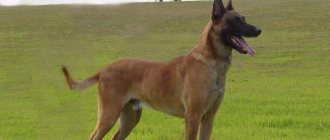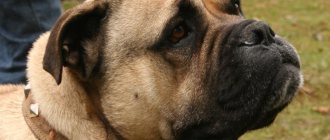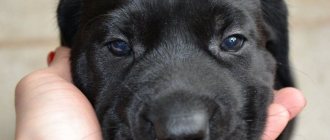Purebred Labrador puppies, as a rule, are available only in specialized nurseries. However, even among amateur dog breeders who are seriously involved in breeding, it is quite possible to find very good representatives of the breed. It is important to decide why you need a dog at all. Or maybe it’s better to get a turtle or a hamster? What will your dog be like when he grows up? We will help you find answers to these questions. We'll tell you how to choose the right future champion and family pet.
There is painstaking work ahead
You saw a cheerful Labrador retriever on the green lawn, happily serving the ball to its owner. You liked his smooth coat shimmering in the sun. I wanted a faithful friend to look into your eyes with the same devotion.
All these wishes can be fulfilled if you take the choice of a pet seriously.
Keep in mind that raising a puppy is painstaking daily work. You will:
- clean up all kinds of dirt after it;
- walk at least twice a day, giving up everything else;
- play like a child;
- feed by the hour;
- give necessary vitamins;
- get timely vaccinations;
- treat in case of illness;
- cultivate the necessary character qualities;
- teach obedience.
You should know that Labradors remain children until they are 2-3 years old. Are you ready to spend some of your precious time on this child? Don't want to part with your dream of a true friend? Then now we will tell you how to choose a Labrador Retriever puppy.
Define your goal
If you are going to raise a winner of various exhibitions, then it is best to find a specialized nursery. There they will show you a complete pedigree, which will indicate all the ancestors of the dog and their awards in the rings. Here you will personally see your pet’s parents and evaluate their qualities.
It doesn’t matter at all where you buy a puppy that you will raise as a family dog. No matter what his appearance becomes after growing up, you will still love him. But even in this case, it doesn’t hurt to get to know his mother and father. Keep in mind that while nursing puppies, the bitch does not look her best. Children take from her everything they need for growth and development. And if the owner does not care enough about it, then he harms his dog. Photographs or videos will help you draw a conclusion about its normal appearance.
Having set a goal in the future to educate your puppy in a canine specialty, you should contact one of the kennel clubs. In small settlements, they usually deal with several breeds at the same time and have a good knowledge of the local market, prices, origin and working qualities of animals.
In large cities there are organizations specializing in one breed. So, without much difficulty you can find a club that deals only with Labrador retrievers.
By taking a puppy there and going through the necessary training course with him, you can very well make him a winner in training competitions. However, it is not a fact that it will meet all the requirements of the external standard.
In our country, it is generally impossible to obtain any guarantees from the breeder. When buying a 1-2 month old baby, you always run the risk of not getting what you wanted. In this situation, everything depends on the integrity and honesty of the seller.
Breed Features
- Devotion to family. Labradors quickly become attached to the family and know how to love everyone at home. Pets get very bored when alone. The Labrador is recognized as the most family-friendly breed.
- Contact with children. Animals have an excellent reputation for bonding with children. They love children immensely, not dividing them into strangers and their own. However, an adult should supervise the contact between a large dog and a baby.
- Attitude towards strangers. Not only the advantage, but also the disadvantage of the Labrador breed is that it is friendly to strangers, as well as to its own. Dog owners don't always like this kindness.
- Security properties. This breed is not suitable for protection. The Labrador's love for others is very great, and he cannot imagine that anyone would want to offend his owner or family members.
- Sentinel signs. Labrador is not suitable as a watchdog. He loves everyone, even strangers who enter the room with bad intentions. Anyone who crossed the threshold of the house is his friend.
- Shedding. The pet is losing a lot of hair. The pet owner will find it on the carpet, sofa and clothes every day. Since the dog is large, there will be a lot of wool. A fumigator, a vacuum cleaner or a thick brush comes to the rescue.
- General health. The breed is not called ideally healthy. Labradors often have serious genetic diseases: allergies, epilepsy, osteoarthritis, joint dysplasia, hyperkeratosis. This dog is indiscriminate in food and prone to gluttony, which can lead to diabetes, obesity, and gastrointestinal problems.
- Activity. Labradors are agile and playful. These qualities are especially evident in puppies. The dog grows up late. Your four-legged friend remains a puppy at heart until he is 3 years old. If training is properly organized, such playfulness can become an advantage.
- Training. The Labrador is great for training. They learn a lot, quickly remember their nickname and basic commands.
The ideal breeder must be a fan
Ideally, the breeder should be happy to show the whelping bitch to the buyer. When communicating, you will immediately feel how much he loves his dog and how he treats it. This is a very important point when choosing a puppy.
People who love animals infinitely will enthusiastically talk about and show them. Doing what they love, they take their bitch to distant cities and even countries for mating. At the same time, they care little about travel expenses. The main thing for them is to choose a worthy pair and get magnificent puppies.
Be careful: breeders should breed, not breed, Labrador Retrievers for profit.
A serious owner usually knows the pedigree of his dog by heart. He can tell detailed details about her ancestors. Having seen in person the conditions in which the bitch and her puppies are kept, you yourself will draw a conclusion about how caring he is. And if all the animals look good, there is no dirt or unpleasant smell around - these are signs of attentive attention and care.
In the future, you can always turn to such a breeder for advice and help. Maybe you will find a very good puppy from him.
Fall in love at first sight
The question of choosing the sex of a Labrador Retriever puppy depends entirely on the personal preferences of the owner. Remember that your dog will not always be a cute and funny little thing. He will definitely grow up and acquire all the features of an adult dog. And each gender has advantages and disadvantages.
Among the external features is the size. A male is always higher at the withers and more powerful in the bones. If he is interesting for his merits for breeding, then he can be bred from 2 to 4 times a month. Services with the father are usually paid for with puppies born from this union. A standard dachshund ranges from 1 to 2 kids. It all depends on the agreement between the owners of the dogs participating in the mating.
One of the advantages of a male dog is that he will never “bring unwanted offspring.” However, his behavior with weak obedience training is very difficult to control when meeting a current bitch. He “falls in love” at first sight.
In general, among Labradors the difference between the sexes is not very pronounced. Everyone serves man equally devotedly. But from time to time it’s still worth showing the dog who’s boss.
About the Labrador breed
The breed was originally bred in Canada for hunting. However, these animals are non-aggressive and good-natured. A large and hardy dog loves water and long walks. The most common and noble colors are chocolate, fawn, and black.
When studying the Labrador Retriever breed, each of us undoubtedly expects that the acquired pet will behave and look according to the standard. However, such a result is guaranteed to be obtained only in the situation where a Labrador puppy was born as a result of breeding work. Note that without the latter, the breed degenerates and loses its unique characteristics.
Women's logic
The main advantage of a bitch is that she gives birth to offspring. An adult female dog comes into heat twice a year. The period lasts approximately 21 days and requires the owner to be extremely careful when walking in open spaces. If you don't keep track, an unplanned mating may happen.
Labradors are a clean breed. And on critical days they take care of themselves. If the dog lives on the street, then the estrus period is unlikely to entail any additional care efforts. In an apartment it is somewhat more difficult, but not so much as to become a big problem.
It is believed that girls are more flexible in character. They are affectionate and gentle in communication, and are caring mothers. But this is the logic and behavior of all females in the world. And Labradors are no exception.
Sometimes females are sold at a higher price than males. But more often the opposite happens.
Labrador Retriever Nutrition
The owner needs to correctly create the pet’s menu.
A large breed needs a lot of food, but the process should be monitored to avoid overfeeding. The pet's daily portion should be from 900 to 1400 g. Natural feeding involves ¾ of the daily ration of meat and meat products, ¼ should be cereal. Suitable lean meats: turkey, chicken, rabbit, horse meat and veal. Preference should be given to stringy pieces.
In addition to meat, the diet should include natural products:
- raw tripe;
- lean fish (sea);
- buckwheat, rice, oatmeal;
- boiled offal;
- greens and vegetables
- rye crackers;
- cheese;
- vegetable oil;
- quail eggs;
- cottage cheese, yogurt;
- vitamin complexes.
Note. It is imperative to maintain a drinking regime. The dog should have clean water around the clock.
Thus, the Labrador is a loyal and affectionate friend who is worth taking good care of. If the owner loves his pet, then the latter will be given and faithful to him until the last day. A truly loving owner will not count every ruble, and, therefore, the question “How much does a Labrador cost?” will be in a secondary position.
Our dear capital
Now let's find out how much a Labrador puppy costs so you can assess your financial capabilities. Analyzing prices on Russian markets, we found out that everything depends on the region where the breeder lives. The merits of his ancestors, that is, pedigree, greatly influence the cost of a puppy. Otherwise, no significant differences were noticed. Often fawn, black and chocolate puppies are sold at the same price. Prices for different genders also differ slightly.
The most expensive Labrador puppies are offered for sale in Moscow. This is due to the fact that the best nurseries and clubs are concentrated in the capital. In addition, the standard of living in such a large city is much higher than in the provinces.
For example, a black male, 2 months old with RKF pedigree, costs $320. A fawn puppy raised to four months is 400. With a more interesting pedigree and champion parents of imported origin, puppies of both sexes 2 months of age cost at least $700.
The same prices apply to the Moscow region and surrounding areas. The cost of puppies from particularly valuable producers reaches up to 1000 euros.
Depends on pedigree
Prices for dogs in St. Petersburg differ slightly from Moscow prices. Using the same principles, they range from $300 to $600.
In the regions, the figures differ greatly from those listed above. Moreover, they vary purely from the wishes of the breeder. You can buy a black male baby for 120 dollars rubles, and a fawn girl for 110. The “vice versa” option is also quite affordable. A brown puppy will cost almost the same. The price is raised by the presence of RKF pedigree and vaccinations. In this case, it reaches 220-240 dollars.
In the provinces of Russia, a common method of purchasing puppies in bulk from capital nurseries at bargain prices is common. Their quality is questionable, but after delivery to the region their cost increases sharply. The main argument: they came from the capital. It is far from a fact that the working qualities and conformation of these dogs will be better than those of a decent local dog breeder.
How to buy
It is better to purchase a dog from a specialized nursery. Pedigree Labrador puppies cost from 15 to 30 thousand rubles. The cost of show class pets reaches 60 thousand. Before contacting a kennel, you need to study reviews about it, prices, photos of dogs.
Puppies
One of the problems when choosing a novice dog breeder is the gender of the pet. Girls are calmer and more obedient. They only have problems with the opposite sex twice a year during estrus. Boys are more active and efficient, inquisitive, and persistent. But they can mark territory.
If you buy a puppy through an advertisement or on the market, it will be cheaper. The price of a dog without a pedigree is 5-10 thousand. But there is no guarantee that the pet will be purebred, healthy and without character flaws.
Judging by the reviews, the Labrador has more advantages than disadvantages. Many believe that this is the best companion, friend and assistant in everything. It is not for nothing that this breed is used as guide dogs and rescuers. She has a genetically inherent desire to serve people. Their love for children and inability to bite humans make them ideal pets for families with children.
Basic Rules
The best age to buy a puppy is 2 months. This figure may fluctuate slightly in both directions, but it is still undesirable to separate the baby from the mother before one month. Before changing its place of residence, the puppy must at least learn to eat on its own. Second: the breeder is obliged to carry out deworming (treatment for worms) in order to rid him of possible parasites. And third: it is desirable that the first vaccinations be done.
Often, the new owner will choose the largest puppy in the litter or the one who approached him first. In fact, these characteristics should not become selection criteria.
You should pay attention to condition, that is, whether the puppy is well-fed. It is important how he knows how to stand, how he moves when walking and running. A small Labrador cannot show aggression towards a stranger.
If you are going to teach him to hunt in the future, then at a minimum his grandparents and parents should be workers in this specialty. It is very important for Labradors to be with a person all the time, starting from birth. It is highly undesirable if they grow in isolation.
Let's clap our hands
Litters that are not too large are considered the best. Ideal - 6-7 puppies. And they should all be approximately the same size. At the age of one month, the height at the withers of the baby is on average 23 cm, weight – 3.5 kg. At two months he already weighs 7-8 kg and grows 7-10 cm upward.
You should not scare your little Labrador with loud shots to test his psyche. But clapping your hands above your head should not terrify him.
A healthy puppy looks happy, plays and eats well. If you pick him up, he doesn't resist. When moving away from his mother and brothers, he does not show feelings of anxiety or whine.
Among the external signs, you should pay attention to the back. It's better if it's short. It is believed that this will further influence the development of a very good “otter” tail. However, a beautiful tail is already visible at birth. Only its length remains unclear. After all, individual parts of the body can grow at different rates.
It's hard to predict how he'll grow up
Your baby's eyes may be light blue at first. They will acquire a permanent color later. You need to pay attention to the expression of the dog's muzzle, and the eyes play a major role. The expression should be pleasant. But this will not happen if the eyes are too far or close to each other, are askew or are not the right size. Choose a puppy with a kind, warm look, without a dull shine in the eyes.
In a healthy baby, the inside of the ears is pink. But it is impossible to predict how they will grow. If the head promises to be large, then those that seem huge now may turn out to be just right in the future. Conversely, ears that are ideal at a young age can completely change their position in an adult dog.
Puppy necks are no less deceptive. However, the deep chest and rounded ribs are immediately visible
It is very difficult to predict what the limbs will become. It is worth paying attention to the absence of a “cow” posture and turning outward. Such defects cannot be corrected later, as well as large angles of articulation between the shoulder blade and shoulder. The hocks should also not be turned out and the paws should not be flattened.
If you liked the article, like it and invite your friends to read it.
Types of puppies and how they differ
In total, according to the classification of the International Cynological Federation, there are 3 types of dogs: pet class, breed class and show class. As stated above, show class dogs are the most elite and expensive ones that meet all standards of a dog’s appearance.
The pet class of dogs are ordinary pets that have no chance of serious achievements at exhibitions, but may well serve as service dogs or simply beloved pets and loyal friends. The last type is the breeding class; dogs of this class are good for breeding. They are unlikely to make business dogs, but they can be used to build a Labrador breeding business.











